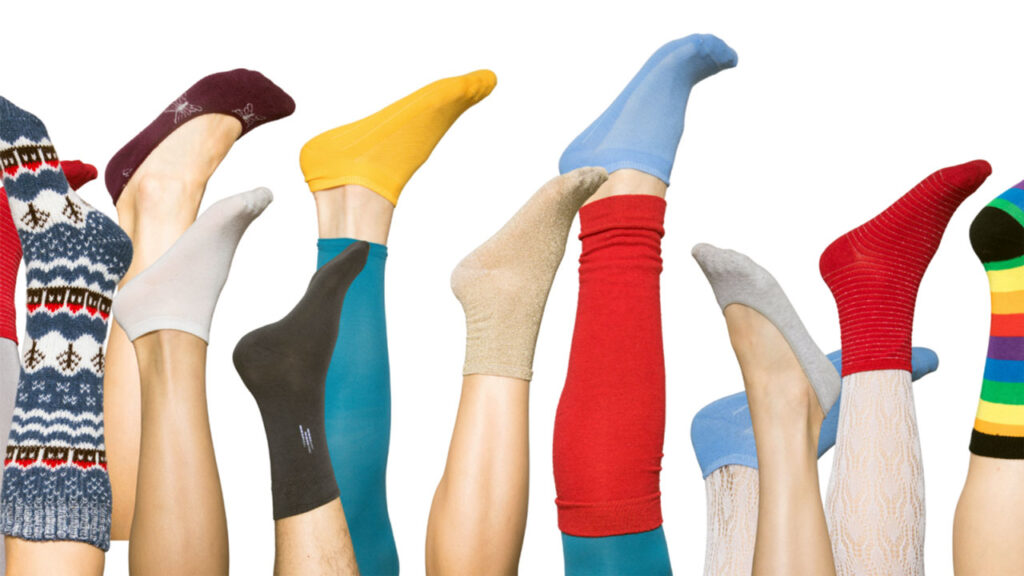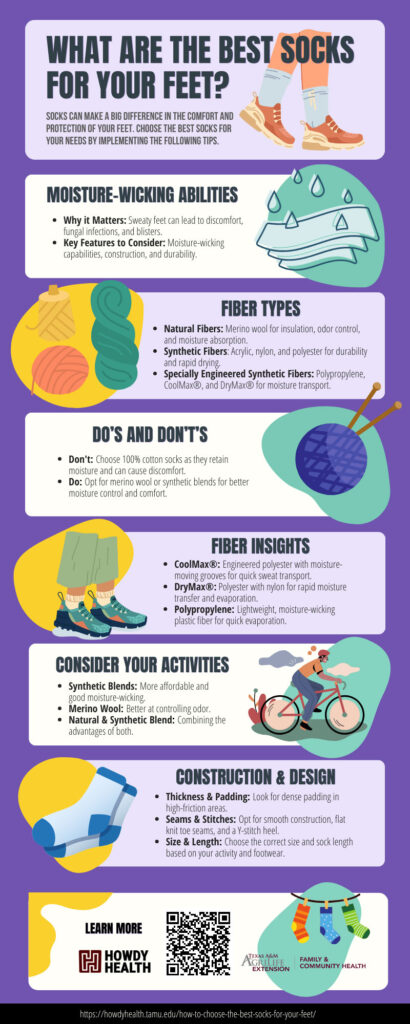While we often talk about the right athletic shoes and clothing, sometimes we forget about our socks. Yet, socks can make a big difference in comfort and protection. So, be sure to choose the best socks for your activity.
Among the most important features of a sock is its moisture-wicking capabilities. Sweaty feet can be hot in the summer and cold in the winter. Sweaty feet are also more susceptible to fungal infections like athlete’s foot and fungal nail infections. Although a shoe needs enough ventilation to allow moisture to evaporate, the sock is the first line of defense. Moisture can also cause friction that can lead to painful sores and blisters. You will also want to consider a sock’s construction and durability.
Got Sweaty Feet?
Keep feet dry and comfortable by taking the following features into consideration when purchasing performance socks.
Fibers
There are two types of fibers, natural and synthetic.
- Natural fibers often found in performance socks include cotton and wool, especially merino wool.
- Synthetic fibers often found in performance socks include acrylic, nylon, and polyester, as well as specially engineered synthetic fibers, like polypropylene, CoolMax®, and DryMax®.
Dos and Don’ts
Don’t choose 100% cotton socks
- Cotton – Many people find themselves asking, “Are cotton socks good for sweaty feet?” We recommend that you don’t choose 100% cotton socks, as cotton absorbs moisture and holds it against your skin. This will jeopardize your foot health by keeping your feet hot in the heat and making them cold in the chill. Moist socks can also bunch up and rub, causing painful abrasions or blisters. Moist, warm feet are also the prime environment for fungal infections to develop.
Do choose merino wool or synthetic blends
- Merino wool – We often shy away from wool thinking it’s scratchy and only for winter. Unlike wool socks of the past, however, merino wool is different. Its finer fibers and natural air spaces make it a good insulator.1 Merino wool is a very soft fiber, and is more absorbent, removing “both excess foot moisture and the uncomfortable heat that can build up in your shoe.”2 It can help keep feet cool in the summer and warm in the winter. It also does a good job of controlling odor.
- Synthetic blends – Synthetic blends are known for their durability as well as their moisture-wicking fibers. Though they are not as good at controlling odor as wool, they typically have a more rapid drying rate than wool. Synthetic blends with specially engineered fibers, like those found in polypropylene, CoolMax , and DryMax socks are often used in performance sock construction.3
- CoolMax® is a type of engineered polyester. Unlike other fibers, CoolMax® fibers aren’t round. They’re slightly oblong with grooves running lengthwise along the threads, and a four-channeled fiber configuration that increases surface area and moisture movement.1,4 CoolMax® has shown excellent performance in the quick transport of “humidity [sweat] from the skin to the environment.”5
- DryMax® is a polyester outer fiber with an abrasion resistant nylon covered Spandex inner layer. 6 Research suggests that nylon has a high thermal conductivity, meaning that it does a good job of transferring heat quickly, but regains moisture faster than polyester.1 Still, the DryMax® fiber combination can quickly transport moisture “away from the foot to the sock’s outer layer and then to the upper part of the shoe where it can evaporate away.”3
- Polypropylene is one of the lightest weight synthetic fibers. It is made from a type of plastic and is often used in clothing where moisture transfer is desired.7 This is because polypropylene cannot absorb any moisture, and instead, moisture passes through it.7 This attribute allows moisture to evaporate much more quickly than it would with a moisture-retaining fiber.7 Therefore, this fabric is popular in textiles that are worn close to the skin.7 For example, polypropylene has shown excellent “capacity to wick moisture from the inner side of the sock to the outer side.”1
Any of the aforementioned wool or synthetic blend socks are going to be the best socks for hot and sweaty feet. Prioritizing foot health is especially important when considering the degree to which walking plays a role in everyday activities.
Things to Consider
Synthetic blends tend to be somewhat less expensive than merino wool socks, while merino wool is typically better at controlling odor. There are also many options that contain both natural and synthetic fibers, such as a merino wool and polypropylene blend,4 which can be good choices. When considering your sock choice, be sure your shoes have good ventilation to allow moisture to escape. If you are in a type of shoe, like a waterproof hiking boot, that does not have good ventilation, you might want to choose a wool blend sock because it has a better absorption capacity, which is important for comfort, coolness, and a less damp feel when footwear won’t allow for moisture evaporation.1 A sock with great moisture wicking properties won’t help if your shoe won’t allow the moisture to evaporate. So, keep that in mind when selecting shoes and socks.
Construction & Design
The way socks are put together can also contribute to the comfort of your feet. Factors to consider when choosing socks include:
- Thickness & Padding – To minimize the forces that cause blisters and abrasions, look for dense padding of the toe, forefoot, and heel, which are most prone to blisters. Research suggests that “denser weave patterns or thicker padding may enhance moisture movement through the sock by reducing compaction and preserving air-space between the fiber networks.”1 You might also choose double-layer socks, which may help “divert friction away from the skin and shift it outward between the sock’s two layers.”3
- Seams & Stiches – Check all the seams for smooth construction. Inspect the toe area and look for flat knit toe seams. Also, look for socks with a Y-stich heel (also called a vector heel pocket).3
- Size & Length – Like shoes, be sure you have the correct size. A sock that is too loose or too tight can cause bunching or pinching of the skin, and blisters.3 You will also want to consider the length of the sock to protect your heels, ankles, and legs, depending on your activity. If you’re walking on smooth surfaces, then you might choose no-show or ankle-length socks, just be sure your heel is protected by the sock to avoid rubbing at the heel of the shoe. If you are walking in nature and/or wearing hiking boots, you will likely need a crew-length or calf-length sock for further protection.
Although research doesn’t clearly identify the perfect composition of sock for athletic wear,1 there are plenty of options to choose from. Try a few types to see what works best for you, your environment, and your type of activity.
Finally, be sure to take care of your feet from the inside out. “Healthy, well-hydrated skin will tolerate more stress before breaking down and developing a friction blister.”3 Be sure to stay well-hydrated especially during warm weather workouts or periods of heavier training efforts.3
Infographic
Download the PDF or share the image below to help others learn about the best socks for their feet.
- Rushton R. Moisture Wicking socks: A research update. Blister Prevention. March 26, 2023. Accessed May 18, 2023. https://www.blister-prevention.com/moisture-wicking-socks/.
- Kinnelon NJ podiatrist shares all socks are not created equal. Ankle & Foot Centers of America. March 21, 2023. Accessed May 18, 2023. https://waynefoot.com/kinnelon-nj-podiatrist-best-socks/.
- Herring KM. How socks make the feet. American Academy of Podiatric Sports Medicine. Accessed May 18, 2023. https://www.aapsm.org/socks-make-the-feet.html.
- Richie DH. Socks and your feet. American Academy of Podiatric Sports Medicine. Accessed May 18, 2023. https://www.aapsm.org/socks-and-your-feet.html.
- Fanguerio R., Gonclaves P., Soutinho F., and Freitas, C. Moisture management performance of functional yarns based on wool fibres. Indian Journal of Fibre and Textile Research. 2009; 34(4):315-320. https://www.researchgate.net/publication/281322653.
- Drymax fiber – A superior technology. DryMax Technologies, Inc. Accessed May 18, 2023. https://www.drymaxsports.com/technology/superior-technology/.
- Hodakel B. What is polypropylene fabric: Properties, how its made and where. Sewport. February 28, 2019. Accessed May 18, 2023. https://sewport.com/fabrics-directory/polypropylene-fabric.





